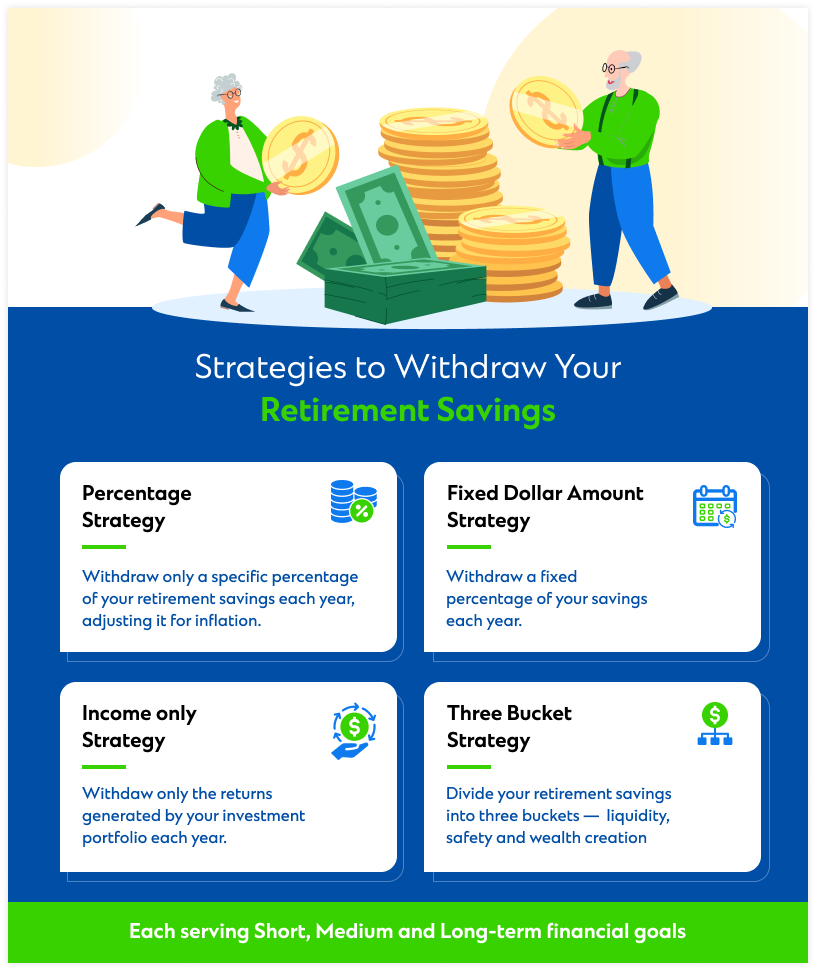

Table of Contents
In a rush? Read this summary:
- Equity investments offer market-linked returns through capital gains and dividends, with no taxation on either for residents in the UAE.
- Life stages usually determine investor approaches: the 20’s-30’s focus on aggressive growth and diversification, the 40’s-50’s on balancing growth with stability, and the 60’s and above on wealth preservation and reducing high-risk exposure.
- Retirement strategies often involve portfolio rebalancing, diversification to reduce risk, and systematic withdrawal approaches like percentage-based, fixed-dollar, or multi-bucket frame-works.
The United Arab Emirates (UAE) has long been hailed as a global financial hub that offers investors seamless access to international markets across geographies, sectors, asset classes, and market capitalisations.
It comes as no surprise, then, that there has always been a strong regional interest in wealth creation through equity investments . And if you haven’t done it already, now is the time to reassess how equities fit into your broader financial strategy.
We’ve therefore curated this guide for discerning investors looking to take a more structured, outcome-driven approach to their investments in the long run, in a bid to maximise their returns. Whether it is diversification or portfolio optimisation, here are a few insights to help you invest with greater conviction.
Mastering basics: A refresher on investing in equities
Equities represent direct ownership of a portion of a publicly listed company sold in the form of shares. This is done to raise capital using debt, via loans or bonds. And the price of these shares reflects a company’s value on a per-unit basis. These share prices fluctuate based on demand and supply, which in turn vary depending on the perception of a company’s prospects as well as broader economic conditions.
Earnings from equities can come primarily in one of two ways: Capital gains (Wherein one sells shares for a price higher than the one they originally bought them for) and dividends (distribution of the profits made by a company to their shareholders). This is what makes them an attractive option. Even more so here in the UAE, wherein capital gains and dividend income are non-taxable for residents .
Now, it is important to remember here that equities offer market-linked returns. Their performance is also contingent upon the performance of the broader market. Bearing this in mind, it is also important to note that they are riskier investments as well. Last but not least, they can be traded on stock markets, making them one of the most liquid asset classes there is. Higher liquidity directly translates to easy access to your cash, as and when you need it.
Equities and you: Evaluating suitability for different investor profiles
Investing in equities is an exercise that can be tailored to individuals regardless of varying financial goals and risk appetites, ages, and geographies. Remember, one’s equity investing journey mirrors different phases of their life.
20’s-30’s (in the early stages of one’s career)
At this age, one may experience major life events such as landing a first job, getting married, and/or buying a home. While there are newfound financial responsibilities to tackle during this period, there also lies an opportunity to build a firm financial foundation. Time being on your side, you can afford to take a more aggressive approach to investing, allocating more capital to higher-risk and higher-return assets.
To capitalise on the advantages of this phase, an investor should:
Diversify
Maintain a diversified equity allocation that fits your risk appetite to maximise wealth accumulation.
Consider low-cost options
Consider low-cost options such as Index funds and Exchange-Traded Funds (ETFs), which replicate the performance of a benchmark rather than trying to outperform it.
Stay disciplined and informed
A blend of discipline, continuous learning and strategic diversification can help build a resilient financial future.
40s-50s (established in careers with a stable income)
In one’s 40s and 50s, financial focus shifts toward balancing growth with risk management. These years are often marked by one’s peak earnings, as well as added responsibilities such as advancing one’s own career, their children’s education, and retirement planning.
It therefore requires a cohesive strategy. As you near retirement, maintaining growth remains important. However, transitioning to more stable and income-generating assets becomes just as important.
Strategies to align investments during this stage of life, as one balances growth with stability include:
Maximise growth potential
In your early 40s, maintain your portfolio’s growth potential by allocating your capital to equities.
Stay diversified, globally
Diversify and invest in bonds and equities from markets globally. This helps achieve the upsides offered by equities, while also helping mitigate risk.
Substitute growth for stability
As retirement inches closer, begin substituting part of your growth equity with high-dividend yield equities to build a stable income stream.
60s and above (retirement)
Retirement brings significant life changes that require a big change in your investment strategy. With the shift from a regular paycheck to relying on savings and investments, careful planning is essential for financial stability.
Healthcare expenses and long-term care costs also become a priority. Additionally, maintaining one’s desired lifestyle, whether it is travel, hobbies or just time with the family, retirement warrants thoughtful investment strategies. The main focus for one at this stage of life is to protect their life savings and preserve wealth.
Common strategies to optimise your investments during retirement include:
Rebalancing your portfolio
Safeguard your savings by rebalancing your investments from equities to debt and bond-based ones and reduce your exposure to high-risk assets.
Diversify to minimise risks
Liquidity and concentration risk in specific securities, sectors and industries are a few risks that aren’t suited to investors in their 60s and beyond. It is therefore a good idea to diversify your investments at such an age across various securities, sectors, and industries.

Implement withdrawal strategies
There is no cap on how long retirement may last.
This makes choosing the right withdrawal strategies just as important as choosing the right investment strategies. Common withdrawal strategies investors can consider include:
Percentage strategy
The percentage strategy involves withdrawing only a certain percentage of one’s retirement savings every year and then adjusting it in the subsequent years for inflation. It typically stands at 4% for the first year, with subsequent increases each year. The strategy helps retirees maintain their purchasing power amidst rising prices.
However, bear in mind that the withdrawals also need to be made according to portfolio and market performance. If you don’t review your portfolio (and subsequent withdrawals) periodically, you may end up diminishing your savings very quickly.
Fixed dollar amount strategy
In contrast to the percentage strategy, a fixed-dollar withdrawal strategy involves withdrawing the same amount of money out of your retirement savings every year, for a set time. It provides one with a predictable income stream, which makes them easier to manage. Bear in mind, however, it does leave you vulnerable to inflationary pressures and unforeseen expenses, especially if your investments aren’t highly liquid.
Income-only strategy
An Income-only strategy refers to one wherein you withdraw only the returns generated by your portfolio each year. This can include rental income, dividends, as well as interest income. This strategy ensures that your principal investment amount never diminishes, and alongside stable income, it also provides you with long-term capital appreciation.
Three-bucket strategy
The 3-bucket strategy, developed by American economist and Nobel Laureate James Tobin, involves dividing your retirement corpus into three separate buckets. Each of these buckets caters to specific requirements during specific periods of an investor’s retirement years.
Liquidity bucket
The liquidity bucket addresses cash flow requirements in the short term, spanning the next two to three years. This includes regular monthly expenses, an emergency fund for unforeseen expenses, as well as other expenses such as healthcare.
This money may be maintained in a savings account, a debt fund, an equity fund, short-term fixed deposits, and/or bonds, etc. Any monthly pension or other regular income may also be included in this bucket. This income may include dividend payouts, rental income, interest income on deposits, distributions from Real Estate Investment Trusts (REITs) and more.
Safety bucket
Once your immediate cash flow needs are taken care of, next comes the safety bucket. The money in the safety bucket is typically used to protect oneself against inflation in the next five years or so.
Also known as the intermediate bucket, it focuses on maintaining a balance between liquidity and returns. This money should therefore be invested in a mix of both – equity as well as debt instruments.
Wealth creation bucket
The wealth creation bucket holds money to be used to grow your wealth.
One can leverage this money in the long run to benefit from the power of compounding to generate more wealth. The wealth creation bucket money may be invested in long-term wealth-generating instruments such as equity and debt mutual funds, gold, real estate, and more.
What’s more, the wealth creation bucket can also be used to address any shortfalls in one’s safety and liquidity buckets.
In the dynamic landscape of the UAE’s equity markets, a strategic and well-informed approach to your investments is paramount for long-term wealth creation and preservation. By understanding the nuances of investing in equities and aligning your strategies with the stage you are at in life, discerning investors can weather the volatility of equity markets with conviction.
Speak to Standard Chartered’s relationship managers or contact us to learn more about investing in equities.



